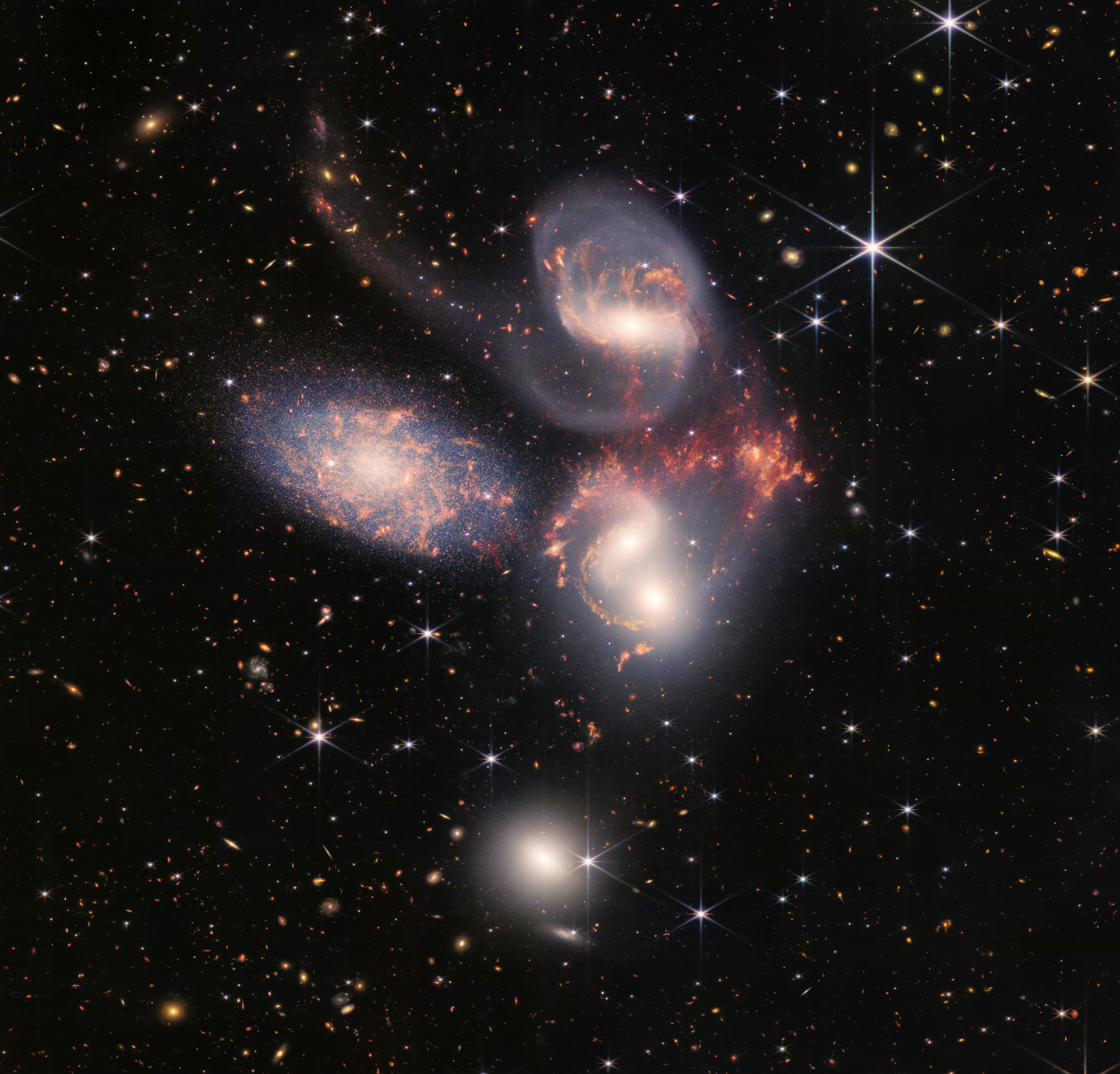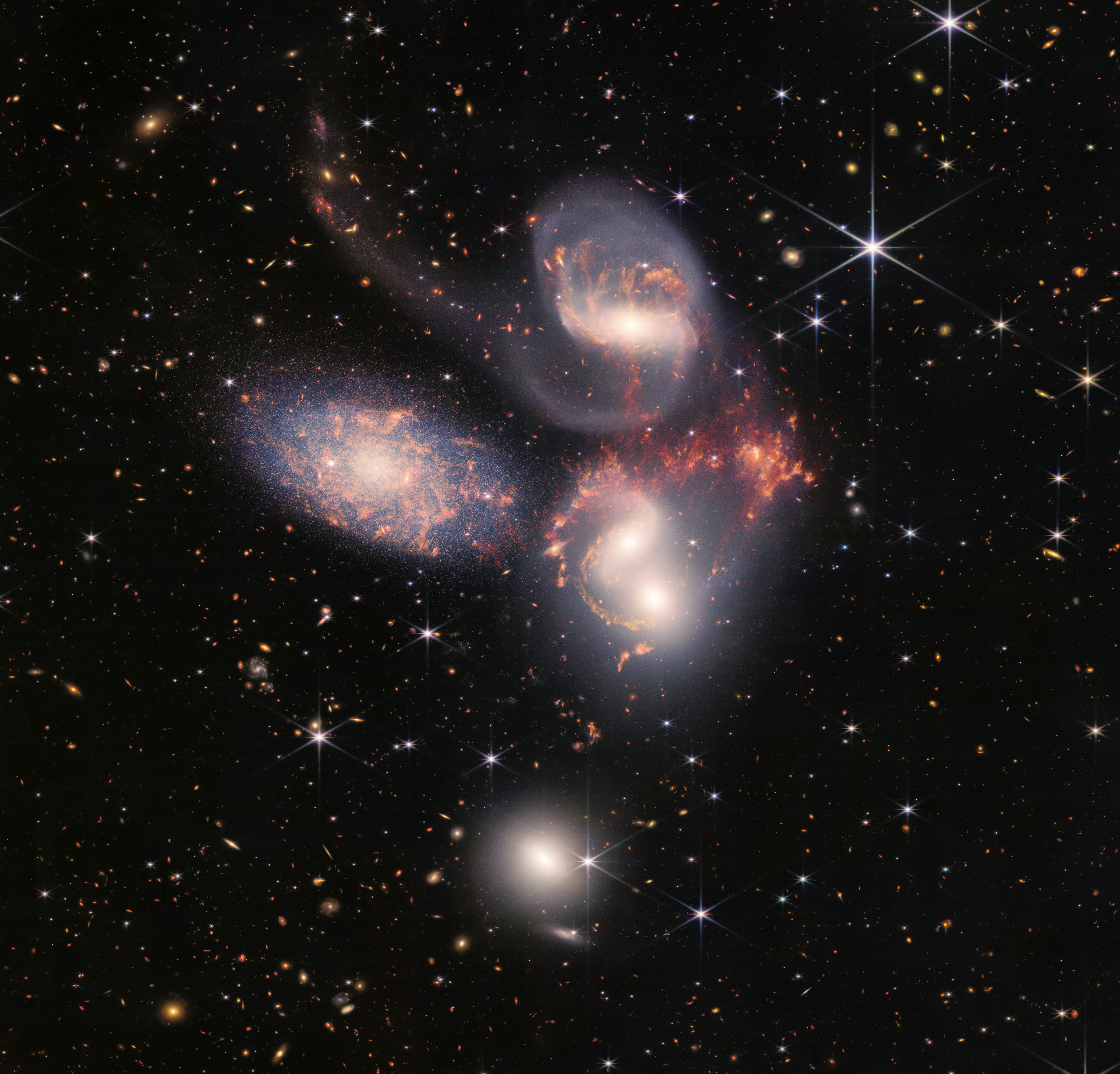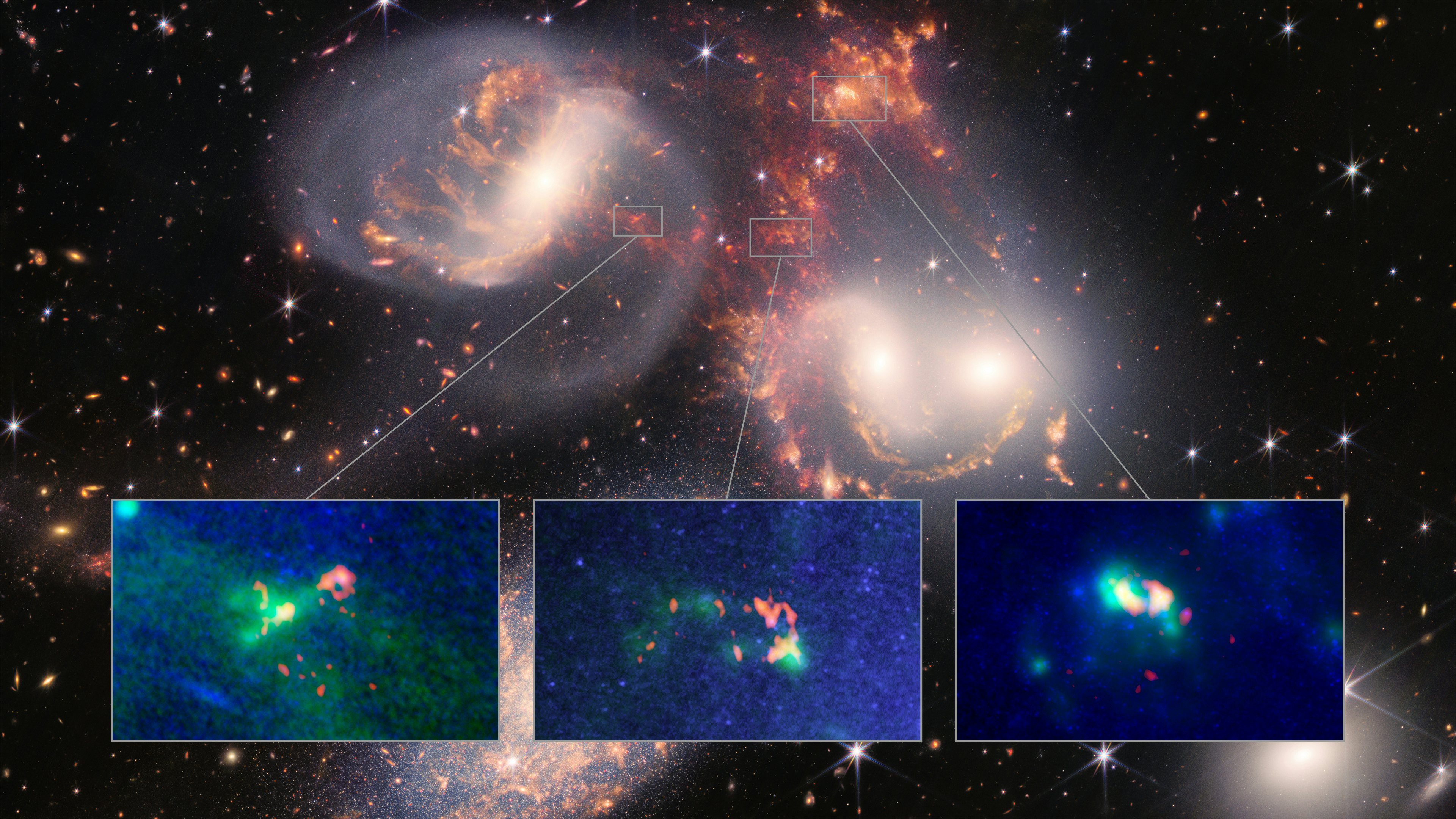
A party-crashing spiral galaxy is plowing headlong into Stephen’s Quintet at nearly 3 million kilometers per hour, causing a shock wave the size of the Milky Way.
As that shock wave blasts through the rest of Stephan’s Quintet, it’s wreaking very confusing havoc on the clouds of gas that float between the galaxies. Astronomers knew weird things were happening in Stephen’s Quintet, a multi-galaxy pileup in progress about 270 million light years away from Earth.
But until recently they didn’t know exactly how weird — or how to explain it. Thanks to recent data from the James Webb Space Telescope (JWST) and the Atacama Large Millimeter/submillimeter Array, a team of astronomers is piecing together the details of what happens when galaxies have high-speed collisions.
They presented their results today at the 241st meeting of the American Astronomical Society.
What’s New — In Stephan’s Quintet (which you might recognize from JWST’s first full-color images released last summer), five galaxies are in the process of smashing into each other, and NGC 7318b, arriving late to the scene, is barreling into the rest of the cosmic train wreck at top speed.

The reckless galaxy is moving so fast, in fact, that it’s moving faster than the speed of sound through the sparse clouds of gas that fill the space between the Quintet’s galaxies.
Yes, sound can travel in space, but only if its wavelengths are longer than the space between molecules — so any sound moving through the cosmos would be so low-frequency that our ears couldn’t hear it. The result is a sonic boom — a shock wave like that made by an airplane breaking the sound barrier here on Earth, except this one is several times the size of the galaxy we live in.
Caltech astronomer Philip Appleton and his colleagues recently used JWST and ALMA to peer into the center of the main shock wave stirred up by gate-crasher galaxy NGC 7318b. They found a flow of superheated, positively-charged hydrogen gas, which is smashing apart a big, dense mass of cold hydrogen gas and sweeping away smaller clumps of that cold gas in its turbulent current. Picture something like a molten lava flow with bits of solid debris caught up in it; it’s not a perfect metaphor, but it conveys the general idea.
When NGC 7318b recklessly plowed into the already-complicated mess going on in Stephan’s Quintet, what it actually collided with was a stream of gas between two of the other galaxies. Sometime in the past, those two galaxies had a near miss, and their gravitational tug-of-war stretched out a long, clumpy stream of gas between them.
That gas was mostly molecular hydrogen, which is made of two hydrogen atoms stuck together.
As NGC 7318b’s shock wave swept over and through that stream of gas, it heated most of the material to millions of degrees centigrade and left a flow of hot, electrically-charged hydrogen rushing swiftly and chaotically in its wake, like a flooded river of extremely hot gas. But some big, dense clumps of cold molecular hydrogen were sturdy enough to weather the initial storm of the shock wave.
That left those clumps of cold gas, like the big one in the Field 6 area Appleton and his colleagues focused on, standing alone against a tumultuous tide of superheated gas. The oncoming current shattered the cold clumps of gas into smaller clouds, which got pulled into the flow.
The result in Field 6, at the heart of the shock wave’s impact, is something that looks like a churning ball of cold gas, with a stream of warm molecular hydrogen and extremely hot hydrogen ions streaming backward from it. And it’s solved a 17-year-old mystery for Appleton and his colleagues.

Here’s the background – The gas that’s superheated by NGC 7318b’s shock wave blazes brightly in the short, high-energy X-ray wavelengths. But back in 2006, Appleton and his colleagues noticed that mixed in with all that bright X-ray emission are lower energy, longer wavelengths of infrared light, which come from much cooler sources. Those specific wavelengths actually came from molecular hydrogen — which was shocking, because hydrogen molecules are distressingly fragile; it doesn’t take much energy to break them apart.
Molecular hydrogen should have disintegrated into electrically-charged hydrogen atoms, or ions, when hit with a shock wave moving at just a fraction of the speed of the one kicked up by NGC 7318b’s galactic gate-crashing. It seemed impossible for there to be molecular hydrogen in the wake of a shock wave ripping through space at 1,000 kilometers per second.
But thanks to high-resolution infrared data from JWST and ALMA, they discovered that they weren’t seeing a ghost, just the shattered remains of very dense clouds of cold gas that had sheltered their interiors from the shock wave.
What’s Next — Stephan’s Quintet still offers plenty of astronomical drama, and plenty of mysteries for humanity’s most powerful telescopes to tackle.
Appleton and his colleagues have figured out which areas of the intergalactic medium between the colliding galaxies contain cold molecular hydrogen, which contain warm molecular hydrogen, and which contain hot hydrogen ions. And they’ve tracked the movement of the coldest gas, thanks to ALMA.
The warm and hot gas, however, still needs to tell its side of the story, Appleton puts it. He and his colleagues hope to use different wavelengths of light to study how fast the warm gas is flowing and how it’s being warmed or cooled by the shock wave.
“The shock wave in the intergalactic medium of Stephen’s Quintet has formed as much cold molecular gas as we have in our own Milky Way, and yet it forms stars at a much slower rate than expected,” says astronomer Pierre Guillard of the Institut d’Astrophysique de Paris, a co-author on the recent study. “Understanding why this material is sterile is a real challenge for theorists.” It could have something to do with the extreme turbulence in the gas clouds and the amount of mixing between hot and cold hydrogen gas.
!["[T]he First and Fifth Amendments Require ICE to Provide Information About the Whereabouts of a Detained Person"](https://images.inkl.com/s3/publisher/cover/212/reason-cover.png?w=600)






